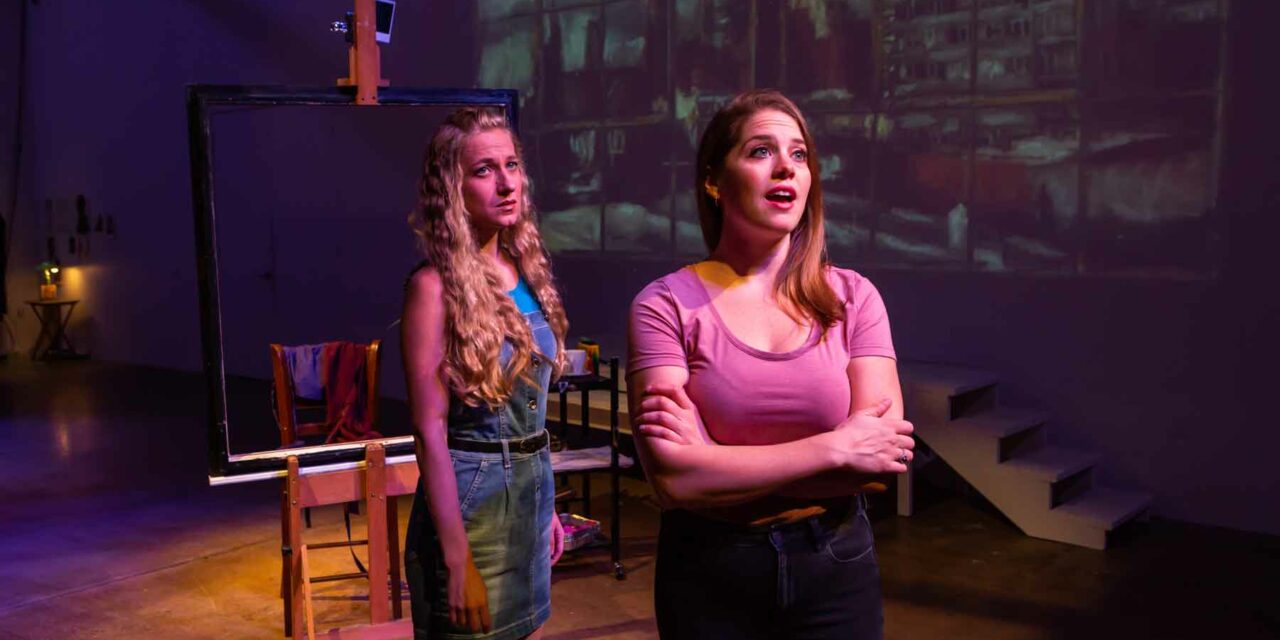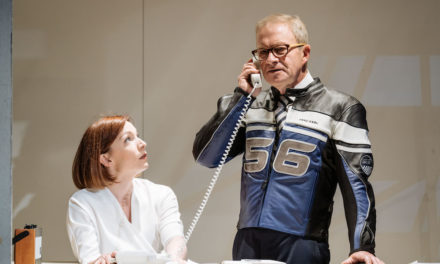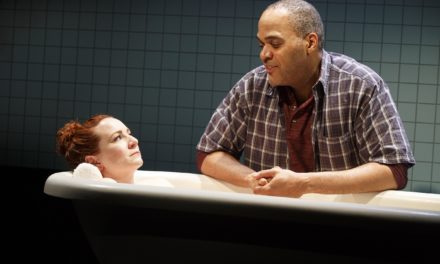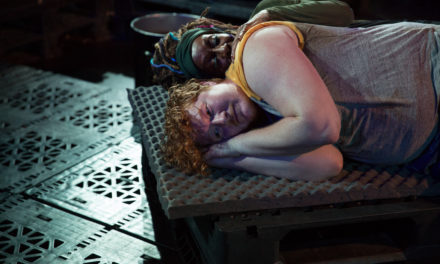Lewis Carroll’s Alice’s Adventures in Wonderland is a popular source of musical adaptions. National Theatre has mounted a production, Wonder.land, in which Alice is trapped in the world of online gaming. MCC’s Alice by Heart set the story in London, during the time of the Blitz. The latest incarnation of Alice is Painted Alice at the Palxall gallery in Long Island City, and this time, she is a struggling painter.
Produced by Greg Schaffert and Long Island City Artist, Painted Alice occupies just a corner of the 12,000 square foot gallery. Here, Alice is a young painter who hits a creative block with her first commissioned work. The stress and anxiety infiltrated her relationship with her partner Dinah, who left their apartment after the two had an argument at a gala. Frustrated with every aspect of her life, Alice “fall[s] through her canvas” and enters a wonderland where Alice’s ideas of art and relationships manifest themselves as various over-the-top characters in comical settings.
The idea of doing a musical about a young artist struggling with the voices in her mind in a real gallery is too tempting for any director to not make it into an immersive piece. But Painted Alice is trapped in the limbo between immersive and not, since director Edjo Wheeler did not decide on either. The audiences are sitting are the two risers making a non-connected “L” shape in the rectangular space. This space proves to be a great restraint for the staging since the emotional focus of dialogue-heavy scenes was projected to the gap between two raisers. The energy in those scenes slips through the cracks among the audiences. The actors also come into the risers and try their best to interact with the audiences, but the audiences lose interest quickly because these interactive blockings are not engaging nor do they add anything to the story. Instead, they often drag down the forward drive in the score and assign more tasks for the already busy five-person ensemble. The show has some really charming moments when the blocking is the simplest, such as a golf ball is dropped from the high-up tech table and bounced into the audiences, but these moments are rare and therefore precious in this production.
Various topics in the contemporary art scene serve as the backbone of William Donnelly’s book. In wonderland, Alice encounters a variety of characters – all bearing some similarities to Carroll’s creations. Among them, there is a mermaid from her childhood drawing, a group of influencers having a deep conversation in a club (the war holes) and a retired painter who made his name by drawing homoerotic cowboy Jesus (who drinks sleep tea now). The scenes staggered on top of each other seemingly lead to no real resolution, until Alice encounters a roller-skating, sword carrying, Renaissance painter named Pratolini (played by Megahn Ginley, same actor as Alice’s partner). The two of them sing a duet about “mak[ing] room for love.” Michael Mahler’s music and lyrics are often fun but messy throughout the show. It is unclear what he wants to achieve in this number. Is it love over art? Or is it about pursuing what you are truly passionate about? The music and book failed to translate the whimsical sublime in Carroll’s writing. They did a good job of translating the absurdism of Carroll and contemporary art, but can Alice learn anything truthful about herself through this ridicule?
The energetic cast of six still manages to shine despite the constraint of the book and direction. You can sense the tension of Tana Sirois’s Alice when she warms up in front of easels during pre-show and in her singing. Sirois’ physicality also allows her to fall into the canvas and leap out of it with grace, although the director didn’t play to her strength much. The rest of the cast plays a range of characters. Adam B. McDonald sings Alice’s inner voice with determination and strength that deeply tortures her. Jack Bowman attacks each of his characters, from a caddie boy to a retired artist, with an unmatched intensity. Jamie Shapiro is often burdened with useless audience interaction, but her high spirit is still affecting. Molly Kelleher has most of the difficult singing, quick changes, and not-so-well-written punchlines, though her almost perfect comedic timing saves it every time.
In most adaptions of Carroll’s story, Wonderland is an alternative reality that can transform Alice. But Carroll never cared for his Alice to learn a lesson, thus he was as free as he can be with the use of symbolism. Painted Alice like many other Alice adoptions, worries too much about reality and lost the simple fun of being in a dream.
This post was written by the author in their personal capacity.The opinions expressed in this article are the author’s own and do not reflect the view of The Theatre Times, their staff or collaborators.
This post was written by Zhe Pan.
The views expressed here belong to the author and do not necessarily reflect our views and opinions.


















